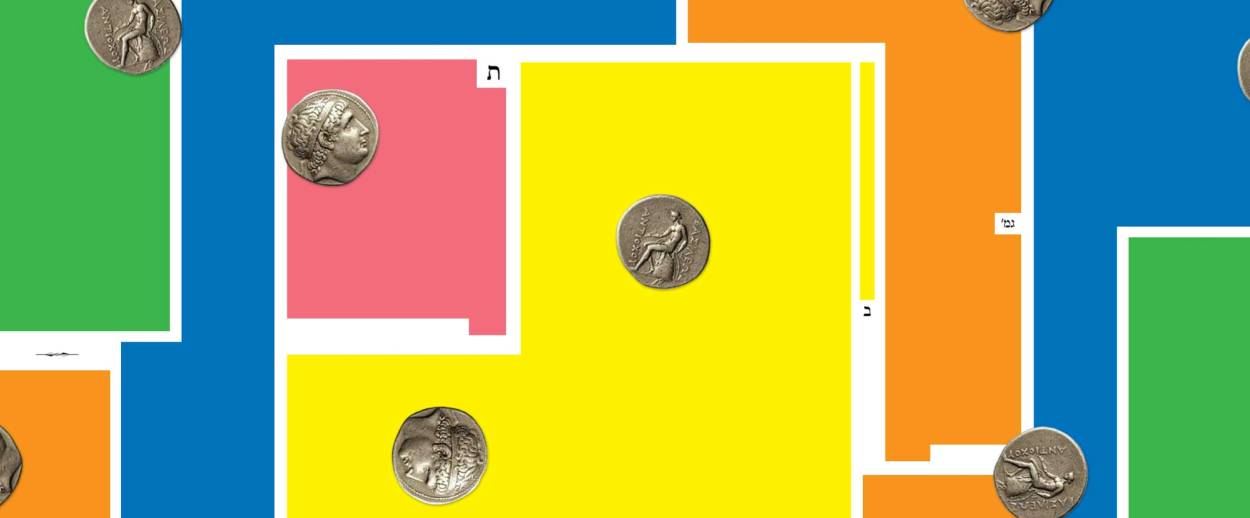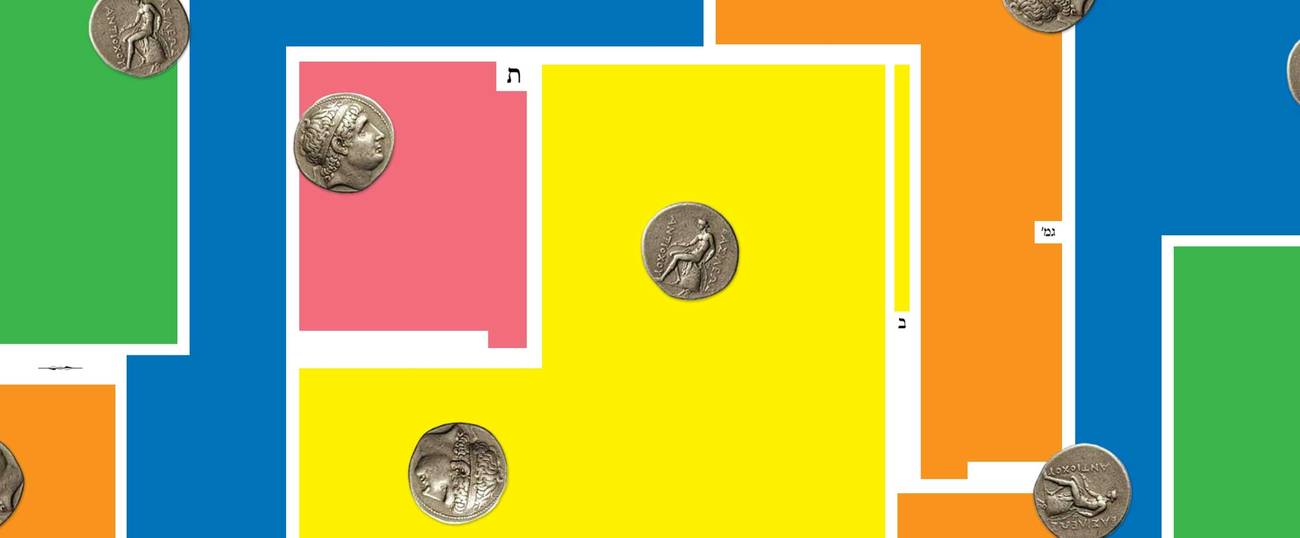The Other Temples
In this week’s ‘Daf Yomi,’ Talmudic rabbis ask if it is possible to do service to the true God in the wrong location




Literary critic Adam Kirsch is reading a page of Talmud a day, along with Jews around the world.
As Daf Yomi readers completed Tractate Menachot this week, we were in for a surprise. From the beginning of the tractate—really, throughout the entire Talmud—it has been understood that there is only one place on the globe where Jewish sacrifices can be brought. That is the Temple in Jerusalem—the structure built by Solomon, destroyed by the Babylonians, rebuilt under the Persians, and then destroyed for good by the Romans in 70 CE. The Temple, of course, was no longer standing when the Talmud was being created, but the rabbis did not contemplate building a replacement somewhere else, because the Bible is very clear that there can be no sacrifices except in the place authorized by God. As Leviticus 17 instructs:
What man soever there be of the house of Israel, that killeth an ox, or lamb, or goat, in the camp, or that killeth it without the camp, and hath not brought it unto the door of the tent of meeting, to present it as an offering unto the Lord before the tabernacle of the Lord, blood shall be imputed unto that man; he hath shed blood; and that man shall be cut off from among his people.
When the Temple was built, it took the place of the Tent of Meeting that the Israelites had used while wandering the desert, and so it was the only place sacrifices could be “presented as an offering unto the Lord.” The Book of Kings records the long struggle of the kings of Judah to wipe out the altars and “high places” of local worship and centralize sacrifice in Jerusalem.
Yet in Menachot 109a, we suddenly learn that, in fact, there was a second Temple all along: the Temple of Onias in Egypt. The Jewish historian Josephus also mentions this Temple of Onias, which was apparently built around the year 170 BCE and stood until the 70s CE, when it was destroyed by the Romans. The Gemara explains that this satellite temple was built by Onias, the son of Shimon HaTzaddik, or Simon the Just, a high priest who lived some time in the 3rd century BCE. (This was Onias III; Josephus, on the other hand, credits the building to his son, Onias IV.) Apparently, this Temple was staffed by priests who offered regular sacrifices. Since Egypt was home to a substantial Jewish population, it’s possible that quite a few Jews would have taken advantage of its proximity, making their offerings close to home instead of having to go all the way to Jerusalem.
In the rabbis’ mind, there is no doubt that the Temple of Onias is inferior to the Jerusalem Temple. But is it completely invalid, so that sacrifices made there are meaningless—or perhaps even worse, a form of idol worship? The mishna seems to compromise on this issue. If a Jew makes a vow to bring a burnt offering and he does so in the Temple of Onias, rather than in Jerusalem, “he has not fulfilled his obligation,” since a proper burnt offering can only be brought in the true Temple. But, the mishna continues, if he specifically pledges to bring the offering “in the temple of Onias,” then doing so fulfills his obligation. This seems to suggest that the Temple of Onias, while not as good as the real Temple, does have some validity.
The Gemara is doubtful about this idea, however, and challenges the mishna’s logic. “How has he fulfilled his obligation” by offering the animal in the Temple of Onias, the rabbis ask? “Hasn’t he merely killed it?” In other words, isn’t slaughtering an animal in a false temple equivalent to slaughtering it in a butcher shop or any other nonsacred location? By saying that such an offering fulfills a vow, the mishna seems willing to compromise on the uniqueness of the Jerusalem Temple. Rather than go along with this, Rav Hamnuna offers a different explanation. It’s not that a vow to offer a sacrifice in the Temple of Onias is a proper vow, he says. Instead, it should be understood as meaning, “It is incumbent upon me to bring a burnt offering [in Jerusalem], on the condition that I will not be responsible if I kill it beforehand.” That is, the vow contains an escape clause, so that killing the animal in Egypt nullifies the promise, rather than fulfilling it.
The next mishna adds that any priest who officiates in the Temple of Onias is disqualified from ever officiating in Jerusalem. “And needless to say,” the rabbis add, “if he served for something else”—a euphemism referring to idol worship—they are also disqualified. But as the Gemara astutely notes in Menachot 109b, this way of putting things implies that service in the Temple of Onias is not itself idol worship. It is service to the true God, though in the wrong location.
All this raises the question of how this satellite Temple came to be built in the first place. The answer lies in one of the best stories I’ve read so far in the Talmud—a Gothic tale that one could easily imagine as an Elizabethan play. The Gemara relates that one year on Yom Kippur, while officiating in the Holy of Holies, Shimon HaTzaddik had a premonition of his own death. “Every Yom Kippur I had a vision in which I would be met by an old man who was dressed in white … and he would enter the Holy of Holies with me, and he would leave with me,” he related. “But this year I was met by an old man who was dressed in black … and he entered with me but he did not leave with me.”
The omen came true, and Shimon died shortly after Sukkot. But before he did, he left instructions that his younger son, Onias, should inherit the High Priesthood, even though Onias was two and a half years younger than Shimon’s older son, Shimi. Although the Torah offers ample precedent for a younger brother being preferred to an older brother—see the stories of Isaac, Jacob, and David, among others—Shimi was understandably upset at being passed over.
So he came up with an ingenious revenge. Promising to teach Onias the proper way for the high priest to dress, he tricked him into wearing the wrong clothes—a tunic belted with a ribbon, rather than the carefully prescribed priestly vestments. Worse, when Onias came to the Temple wearing this outfit, Shimi told everyone that he was doing it on purpose to please his sweetheart: “Look what this man vowed and fulfilled for his beloved, that he had said to her: On the day that I serve in the High Priesthood I will wear your tunic and gird your ribbon.” Coming from a chivalric knight of the Middle Ages, this kind of gesture might have been appreciated, but to the Jerusalem priesthood nothing could have appeared more frivolous than preferring a woman to the Law.
Furious at this blasphemy, the priests “wanted to kill” Onias, so he ran away to Alexandria in Egypt, home of the biggest Jewish community outside the Land of Israel. There he “built an altar and sacrificed upon it for the sake of idol worship,” setting up a rival Jewish Temple under his own authority. (Josephus says that this Temple was not in Alexandria, but in the city of Leontopolis. But then, the rabbis are seldom concerned with such historical details.) Rabbi Yehuda, however, says that even in this spurious Temple, the sacrifices were not idol worship but “for the sake of Heaven.” Indeed, the Temple of Onias can even be justified as fulfilling the prophecy of Isaiah, who predicted that one day “there shall be an altar to the Lord in the midst of the Land of Egypt.” With this story, the Talmud offers a glimpse of a diasporic Jewish reality that was very different from the idealized, Temple-centric vision of the rabbis.
***
Adam Kirsch embarked on the Daf Yomi cycle of daily Talmud study in August 2012. To catch up on the complete archive, click here.
Adam Kirsch is a poet and literary critic, whose books include The People and the Books: 18 Classics of Jewish Literature.